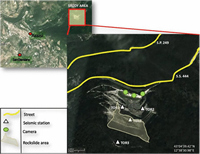Seismic Monitoring of a Rockslide: The Torgiovannetto Quarry (Central Apennines, Italy)
Lotti A., G. Saccorotti, A. Fiaschi, L. Matassoni, G. Gigli, V. Pazzi, N. Casagli (2015).
Engineering Geology for Society and Territory, Volume 2, Pages 1537-1540, doi: 10.1007/978-3-319-09057-3_272
Abstract
A small-scale seismic network was deployed in the Torgiovannetto quarry (Central Apennines, Italy) from December 2012 to July 2013 to evaluate the possibility of improving the early-warning monitoring network of a rockslide by means of seismic observations. Four seismometers, acquiring data in continuous mode, were set up inside and at the edge of the quarry, with an average inter-station distance of about 100 m. The entire data set (7 months of recording) was analyzed through three different procedures: an STA/LTA (short-time-average /long-time-average) trigger, HVSR (Horizontal to Vertical Spectral Ratio and NCF (Noise-Correlation Function). The data analysis is still in progress. The preliminary data processing related to the identification and classification of recorded signals shows promising results but further refinements of the adopted algorithms are necessary in order to make this technique an helpful early warning tool. Extensive comparison and cross-analysis with parameters independently recorded by the other instruments of the monitoring network are necessary to reach the goals of the study.
http://link.springer.com/chapter/10.1007%2F978-3-319-09057-3_272


